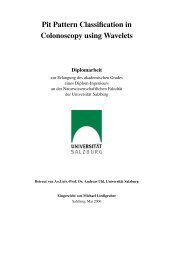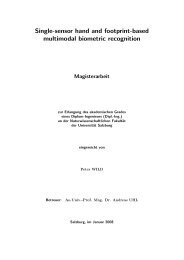A Survey of H.264 AVC/SVC Encryption
A Survey of H.264 AVC/SVC Encryption
A Survey of H.264 AVC/SVC Encryption
Create successful ePaper yourself
Turn your PDF publications into a flip-book with our unique Google optimized e-Paper software.
6Online / Offline Scenario: The computational complexity<strong>of</strong> an encryption scheme also is a decisive factor for itsapplicability. Depending on the application context, the videodata is available in a raw, uncompressed format and <strong>H.264</strong>compression has to be conducted anyway (this is referredto as online scenario [68], e.g., video conferencing) or thevideo data is already available as compressed <strong>H.264</strong> bitstream(this is referred to as <strong>of</strong>fline scenario [68]). This distinction isnecessary for the assessment <strong>of</strong> the computational complexity<strong>of</strong> a video encryption scheme, as most compression-integratedschemes are only feasible in an online scenario (for complexityreasons), as they require computationally demanding parts <strong>of</strong>the compression pipeline to be performed.The application context may further require that certainproperties and associated functionalities <strong>of</strong> the video bitstreamare preserved in the encrypted domain. Thus the main assessableproperties <strong>of</strong> a video encryption scheme in a security andapplication scenario are:• Security (in a certain application scenario with respect tothe specific security notion)• Compression efficiency• Computational complexity• Preserved functionality (format-compliance, packetization,scalability, transcodability, and watermarking)IV. AN OVERVIEW OF <strong>H.264</strong> [ENCRYPTION]A. <strong>Encryption</strong> before CompressionIf encryption is conducted before compression, the mostimportant issue is the influence on <strong>H.264</strong> compression performance.Thus if the entire visual information should beconcealed, these approaches are not the method <strong>of</strong> choice,but if smaller areas need to be concealed, encryption beforecompression has been proposed. For privacy preservation thestraight-forward solution would be to cut out the privacyendangeringareas and code them independently and encryptthem afterwards. Another solution is to encrypt image areasand encode the modified image, e.g., a permutation <strong>of</strong> positions<strong>of</strong> the pixels in the privacy-endangering areas is proposedin [9]. With respect to <strong>H.264</strong> the following aspects need tobe considered: Is decryption after lossy <strong>H.264</strong> compressionstill possible (it is possible with pixel position permutations)and how can the influence on compression performance beminimized, which is more easily achieved when encryption isperformed in the compression pipeline [12], [13], [67].B. Compression [Integrated <strong>Encryption</strong>]In <strong>H.264</strong> a picture is processed in blocks, starting with16x16 macroblocks, which can be further sub-divided in ahierarchical tree fashion down to 4x4 blocks. The macroblockscan be grouped in slices, but most commonly a slice consists<strong>of</strong> the macroblocks <strong>of</strong> an entire picture (default configurationin most encoders). In an IDR picture (instantaneous decoderefresh picture, similar to I-frames in previous standards) onlyintra-coding is permitted and all previously decoded referencepictures will not be used in the further decoding process.Index Codeword mb qp delta0 1 11 01 0 12 01 1 -13 001 00 24 001 01 -25 001 10 36 001 11 -37 0001 000 48 0001 001 -4. . . . . . . . .TABLE IIEXPONENTIAL GOLOMB CODE ENCRYPTION1) Intra-Prediction [Mode <strong>Encryption</strong>]: Intra-predictionmay only take advantage <strong>of</strong> the previously coded data <strong>of</strong>the current slice. In intra-coding the pixel data <strong>of</strong> a blockcan be either predicted on the basis <strong>of</strong> previous block data(in raster scan order) or transmitted directly (I PCM mode).The prediction mode has to be signalled in the bitstream,modification <strong>of</strong> the intra-prediction modes for encryption hasbeen proposed in [1], [36], [7], [39], [37], [38], [40], [56], [62].A visual example <strong>of</strong> a encryption <strong>of</strong> the intra-prediction modesis shown in figure 10(a). The encryption <strong>of</strong> the intra-predictionmodes is very similar in all contributions. The intra-predictionmodes are encoded with exponential Golomb codes, the formatand length preserving encryption <strong>of</strong> exponential Golomb codesis illustrated in table II. Table II shows exponential Golombcode word and the associated value for the syntax elementmb qp delta, which changes the quantization parameter on amacroblock basis. Exponential Golomb codes have a prefix,the leading zeros until the first one, which signals the length <strong>of</strong>the suffix. The suffix is an arbitrary bitstring <strong>of</strong> the signalledlength. This suffix can be conventionally encrypted withoutcompromising the format-compliance, i.e., the resulting ciphertextsare still valid exponential Golomb codes. The suffixare the bits contained in the boxes in table II.The intra-prediction produces residual data (the differenceto the intra-prediction), macroblock partition information, andintra-prediction mode information.2) Inter-Prediction [Mode <strong>Encryption</strong>]: In inter-predictionblocks are predicted on the basis <strong>of</strong> previously decoded referencepictures. For that end motion estimation and compensationis conducted, a novelty <strong>of</strong> <strong>H.264</strong> is the tree-structuredmotion estimation and compensation, which employs variableblock sizes. Some inter frame macroblock subdivisions resultin the same number <strong>of</strong> motion vectors. In [36] it is proposedto perform permutations on the set <strong>of</strong> inter frame macroblocksubdivisions with the same number <strong>of</strong> motion vectors.The results <strong>of</strong> inter-prediction are residual data (the differenceto the inter-prediction), the macroblock partition information,the inter-prediction mode and the motion vector data.3) Motion Vector [Difference <strong>Encryption</strong>]: Motion estimationand compensation works on a macroblock basis (16x16blocks), which can be further decomposed to 4x4 blocks. For








